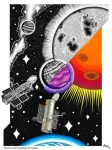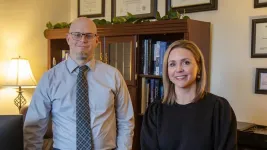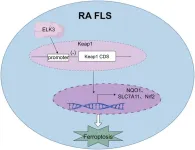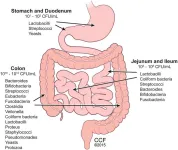(Press-News.org) Most of the information we have about planets beyond our solar system (exoplanets) comes from looking at dips in starlight as these planets pass in front of their host star.
This technique can give clues about the planet’s size (by looking at how much starlight is blocked) and what its atmosphere is made of (by looking at how the planet changes the pattern of starlight that passes through it).
But a new study, published in The Astrophysical Journal Supplement Series, concluded that fluctuations in the starlight due to hotter and colder regions on a star’s surface may be distorting our interpretations of planets more than we previously thought.
The researchers looked at the atmospheres of 20 Jupiter- and Neptune-sized planets and found that the host stars’ changeability distorted the data for about half of them.
If researchers did not properly account for these variations, the team said, they could misinterpret a range of features such as the planets’ size, temperature and the composition of their atmospheres. The team added that the risk of misinterpretation was manageable if researchers looked at a range of wavelengths of light, including in the optical region where effects of stellar contamination are most apparent.
Lead author Dr Arianna Saba (UCL Physics & Astronomy), who did the work as part of her PhD at UCL, said: “These results were a surprise – we found more stellar contamination of our data than we were expecting. This is important for us to know. By refining our understanding of how stars’ variability might affect our interpretations of exoplanets, we can improve our models and make smarter use of the much bigger datasets to come from missions including James Webb, Ariel and Twinkle.”
Second author Alexandra (Alex) Thompson, a current PhD student at UCL Physics & Astronomy whose research focuses on exoplanet host stars, said: “We learn about exoplanets from the light of their host stars and it is sometimes hard to disentangle what is a signal from the star and what is coming from the planet.
“Some stars might be described as ‘patchy’ – they have a greater proportion of colder regions, which are darker, and hotter regions, which are brighter, on their surface. This is due to stronger magnetic activity.
“Hotter, brighter regions (faculae) emit more light and so, for instance, if a planet passes in front of the hottest part of the star, this might lead researchers to over-estimate how large the planet is, as it will seem to block out more of the star’s light, or they might infer the planet is hotter than it is or has a denser atmosphere. The reverse is true if the planet passes in front of a cold starspot, making the planet appear ‘smaller’.
“On the other hand, the reduction in emitted light from a starspot could even mimic the effect of a planet passing in front of a star, leading you to think there might be a planet when there is none. This is why follow up observations are so important to confirm exoplanet detections.
“These variations from the star can also distort estimates of how much water vapour, for instance, is in a planet’s atmosphere. That is because the variations can mimic or obscure the signature of water vapour in the pattern of light at different wavelengths that reaches our telescopes.”
For the study, researchers used 20 years of observations from the Hubble Space Telescope, combining data from two of the telescope’s instruments, the Space Telescope Imaging Spectrograph (STIS) and the Wide Field Camera 3 (WFC3).
They processed and analysed the data for each planet in an identical way, to ensure they were comparing like with like, minimising the biases that occur when datasets are processed using different methods.
The team then looked at which combination of atmospheric and stellar models fit their data the best, comparing models that accounted for stellar variability with simpler models that did not. They found that data for six planets out of the 20 analysed had a better fit with models adjusted for stars’ variability and six other planets may have experienced minor contamination from their host star.
They analysed light at visible, near-infrared and near-ultraviolet wavelengths, using the fact that distortions from stellar activity are much more apparent in the near-UV and visible (optical) region than at longer wavelengths in the infrared.
The team described two ways to judge if stellar variability might be affecting planetary data.
Dr Saba explained: “One is to look at the overall shape of the spectrum – that is, the pattern of light at different wavelengths that has passed through the planet from the star – to see if this can be explained by the planet alone or if stellar activity is needed. The other is to have two observations of the same planet in the optical region of the spectrum that are taken at different times. If these observations are very different, the likely explanation is variable stellar activity.”
Alex Thompson added: "The risk of misinterpretation is manageable with the right wavelength coverage. Shorter wavelength, optical observations such as those used in this study are particularly helpful, as this is where stellar contamination effects are most apparent."
END
Temperamental stars are distorting our view of distant planets
2025-02-07
ELSE PRESS RELEASES FROM THIS DATE:
DOE’s Office of Science is now Accepting Applications for Office of Science Graduate Student Research Awards
2025-02-07
Washington, D.C. – The U.S. Department of Energy’s (DOE) Office of Science is pleased to announce that the Office of Science Graduate Student Research (SCGSR) program is now accepting applications for the 2025 solicitation 1 cycle. Applications are due on Wednesday, May 7, 2025, at 5:00 p.m. ET.
SCGSR application assistance workshops will be held on March 6, 2025, 2:00 p.m.–3:30 p.m. ET and April 10, 2025, 2:00 p.m.–4:30 p.m. ET. The first workshop ...
Twenty years on, biodiversity struggles to take root in restored wetlands
2025-02-07
While the restoration of natural areas is high on political agendas, a comprehensive new study from the University of Copenhagen shows that – after more than two decades – biodiversity growth has stalled in restored Danish wetlands. The results also suggest that time alone will not heal things because the areas are too small and dry, and nitrogen inputs from agriculture continue. According to the researchers, we need to learn from the past.
The benefits are clear: natural areas with high biodiversity absorb ...
Do embedded counseling services in veterinary education work? A new study says “yes.”
2025-02-07
COLUMBIA, Mo. -- Embedded counseling services are becoming increasingly common in veterinary medical programs, but their effectiveness has not historically been measured. A new study by University of Missouri researchers revealed that these programs may not only enhance access to mental health care but also lead to significant reductions in psychological distress among veterinary trainees.
“It’s the first study, as far as we know, to evaluate the effectiveness of mental health counseling for veterinary trainees,” said Kerry Karaffa, PhD, a licensed psychologist at the ...
Discovery of unexpected collagen structure could ‘reshape biomedical research’
2025-02-07
Collagen, the body’s most abundant protein, has long been viewed as a predictable structural component of tissues. However, a new study led by Rice University’s Jeffrey Hartgerink and Tracy Yu, in collaboration with Mark Kreutzberger and Edward Egelman at the University of Virginia (UVA), challenges that notion, revealing an unexpected confirmation in collagen structure that could reshape biomedical research.
The researchers used advanced cryo-electron microscopy (cryo-EM) to determine the atomic structure of a packed collagen assembly that deviates from the traditionally accepted right-handed superhelical twist. ...
Changes in US primary care access and capabilities during the COVID-19 pandemic
2025-02-07
About The Study: In this cohort study, over the time period including the COVID-19 pandemic, primary care practices reported a decline in access to care, while average practice capabilities improved. Integrated practice ownership and accountable care organization participation were both associated with better access and capability scores, suggesting that value-based payment and integrated care delivery support the development of higher-quality primary care. Variations across practices point to large opportunities for improvement overall and underscore the importance of incentives and structures as levers to improve primary care delivery.
Corresponding Author: To contact the ...
Cardiometabolic trajectories preceding dementia in community-dwelling older individuals
2025-02-07
About The Study: In this study of older individuals, decline in body mass index, waist circumference, and high-density lipoprotein (HDL) occurred up to a decade before dementia diagnosis. These findings provide insights into cardiometabolic changes preceding dementia and the potential for early monitoring and intervention.
Corresponding Author: To contact the corresponding author, Zimu Wu, PhD, email zimu.wu1@monash.edu.
To access the embargoed study: Visit our For The Media website at this link https://media.jamanetwork.com/
(doi:10.1001/jamanetworkopen.2024.58591)
Editor’s Note: Please see the article for additional information, ...
Role of ELK3 in ferroptosis of rheumatoid arthritis fibroblast-like synoviocytes
2025-02-07
Background and objectives
Rheumatoid arthritis (RA) is an inflammatory arthritis characterized by chronic joint inflammation, cartilage degradation, and bone erosion. ELK3 is a transcriptional repressor that can affect cell proliferation, migration, invasion, apoptosis, and other cellular processes. The study aimed to clarify the effect of ELK3 in the biological activity and ferroptosis phenotype of RA fibroblast-like synoviocytes (FLS), and to reveal its molecular mechanism in regulating ferroptosis in RA FLS.
Methods
We investigated the impact of ELK3 on the biological activity and ferroptosis phenotype of RA FLS using real-time quantitative polymerase chain reaction, immunohistochemistry, ...
Team of Prof. Woo Young Jang Department of Orthopedic Surgery, KU Anam Hospital wins the Best Paper Award from the Korean Musculoskeletal Tumor Society
2025-02-07
Professor Woo Young Jang (Department of Orthopedic Surgery, Korea University Anam Hospital) recently won the best paper award at the 2024 fall academic conference of the Korean Musculoskeletal Tumor Society held in November 22th, 2024. This award recognizes the outstanding results and academic value of the research led by Professor Jang.
Professor Woo Young Jang, in collaboration with Professor Jun Seok Lee from the Department of Pharmacology and Dr. Jang Sun Hwang from the Department of Orthopedic Surgery at Korea University College of Medicine, conducted the research ‘Disaggregation-Activated ...
Terasaki Institute for Biomedical Innovation announces recipients of inaugural Keith Terasaki Mid-Career Innovation Award
2025-02-07
Los Angeles, CA – February 7, 2025 - The Terasaki Institute for Biomedical Engineering (TIBI) is pleased to announce their selection of Dr. Liangfang Zhang - Irwin Jacobs Chancellor’s Endowed Chair Professor at the University of California San Diego, and Dr. Aydogan Ozcan – Chancellor’s Professor, UCLA & Professor, Howard Hughes Medical Institute (HHMI), as the recipients of the inaugural Keith Terasaki Mid-Career Innovation Award. These awards will be presented at the 3rd Annual Terasaki Innovation Summit, to be held March ...
The impact of liver graft preservation method on longitudinal gut microbiome changes following liver transplant
2025-02-07
Background and Aims
End-stage liver disease is associated with disruptions in gut microbiota composition and function, which may facilitate gut-to-liver bacterial translocation, impacting liver graft integrity and clinical outcomes following liver transplantation. This study aimed to assess the impact of two liver graft preservation methods on fecal microbiota and changes in fecal and breath organic acids following liver transplantation.
Methods
This single-center, non-randomized prospective pilot study enrolled liver transplant patients whose grafts were preserved using either static cold storage or ex situ normothermic machine perfusion (NMP). Fresh stool ...






